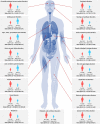Gender differences in adverse event reports associated with antidiabetic drugs
- PMID: 33067519
- PMCID: PMC7567832
- DOI: 10.1038/s41598-020-74000-4
Gender differences in adverse event reports associated with antidiabetic drugs
Abstract
Little is known about gender-specific reporting of adverse events (AEs) associated with antidiabetic drugs. This study was to assess the gender-related difference in AEs reporting associated with antidiabetic agents. The number of antidiabetic drug-AE pairs associated was identified using the Korea Adverse Event Reporting System database. Prevalence of diabetes was estimated using the Health Insurance Review and Assessment Service-National Patients Sample database. Reporting rate per 10,000 people was calculated by dividing drug-AE pairs with the number of antidiabetic drug users by gender. Gender difference was presented with risk ratio (reporting rate ratio) of women to men. Antidiabetic agent-associated AEs were more frequently reported by women than men throughout body organs and drug classes. 13 out of 17 system organ class level disorders with significant gender differences were reported more often by women than men. By drug class, gender-specific reporting rates were observed in most of the drug classes, especially in newer classes such as glucagon-like peptide-1 analog (GLP1-RA), sodium glucose co-transporter-2 inhibitor (SGLT2i), and thiazolidinedione (TZD). Looking into preferred term level for each drug class, women dominated the reports of class-specific AEs of newer antidiabetic drugs such as urinary tract/genital infection (all reported by women) in SGLT2i, edema in TZD (risk ratio (RR) 12.56), and hyperglycemia in insulin users (RR 15.35). Gender differences in antidiabetic-associated AE reporting often attributed to women. Explanations for these different report levels by gender should be further investigated.
Conflict of interest statement
The authors declare no competing interests.
Figures

Similar articles
-
Signal Detection for Cardiovascular Adverse Events of DPP-4 Inhibitors Using the Korea Adverse Event Reporting System Database, 2008-2016.Yonsei Med J. 2019 Feb;60(2):200-207. doi: 10.3349/ymj.2019.60.2.200. Yonsei Med J. 2019. PMID: 30666842 Free PMC article.
-
Adverse events with sodium-glucose co-transporter-2 inhibitors: A global analysis of international spontaneous reporting systems.Nutr Metab Cardiovasc Dis. 2017 Dec;27(12):1098-1107. doi: 10.1016/j.numecd.2017.10.008. Epub 2017 Oct 18. Nutr Metab Cardiovasc Dis. 2017. PMID: 29174026
-
Comparison of the Effects of Glucagon-Like Peptide Receptor Agonists and Sodium-Glucose Cotransporter 2 Inhibitors for Prevention of Major Adverse Cardiovascular and Renal Outcomes in Type 2 Diabetes Mellitus.Circulation. 2019 Apr 23;139(17):2022-2031. doi: 10.1161/CIRCULATIONAHA.118.038868. Circulation. 2019. PMID: 30786725
-
Cardiovascular, ocular and bone adverse reactions associated with thiazolidinediones: a disproportionality analysis of the US FDA adverse event reporting system database.Drug Saf. 2012 Apr 1;35(4):315-23. doi: 10.2165/11596510-000000000-00000. Drug Saf. 2012. PMID: 22376166
-
Cost Effectiveness of Sodium-Glucose Cotransporter-2 (SGLT2) Inhibitors, Glucagon-Like Peptide-1 (GLP-1) Receptor Agonists, and Dipeptidyl Peptidase-4 (DPP-4) Inhibitors: A Systematic Review.Pharmacoeconomics. 2019 Jun;37(6):777-818. doi: 10.1007/s40273-019-00774-9. Pharmacoeconomics. 2019. PMID: 30854589
Cited by
-
Overcoming Disparities in Using SGLT2 Inhibitors for Cardiorenal Protection in Persons With and Without Type 2 Diabetes.J Clin Endocrinol Metab. 2025 Aug 7;110(9):e2852-e2863. doi: 10.1210/clinem/dgaf301. J Clin Endocrinol Metab. 2025. PMID: 40420813 Free PMC article.
-
Analysis of sex-differential gene expression on the target of approved drug.Sci Rep. 2025 Jul 24;15(1):26989. doi: 10.1038/s41598-025-12342-7. Sci Rep. 2025. PMID: 40707586 Free PMC article.
-
Sex differences in type 2 diabetes.Diabetologia. 2023 Jun;66(6):986-1002. doi: 10.1007/s00125-023-05891-x. Epub 2023 Mar 10. Diabetologia. 2023. PMID: 36897358 Free PMC article. Review.
-
Underrepresentation of Women in Recent Landmark Kidney Trials: The Gender Gap Prevails.Kidney Int Rep. 2022 Sep 2;7(11):2526-2529. doi: 10.1016/j.ekir.2022.08.022. eCollection 2022 Nov. Kidney Int Rep. 2022. PMID: 36531883 Free PMC article. No abstract available.
-
A Captivating Potential of Schiff Bases Derivatives for Antidiabetic Activity.Curr Pharm Des. 2025;31(1):37-56. doi: 10.2174/0113816128339161240913055034. Curr Pharm Des. 2025. PMID: 39313905 Review.
References
Publication types
MeSH terms
Substances
LinkOut - more resources
Full Text Sources
Medical

